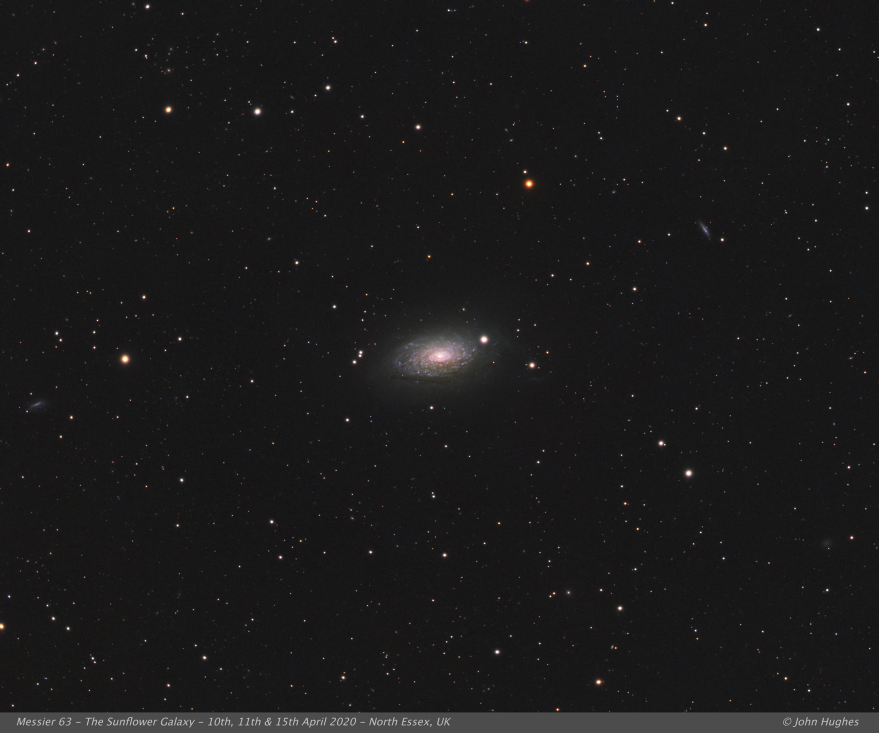A galactic sunflower.....
My rendition of Messier 63, the Sunflower Galaxy which is located in the constellation of Canes Venatici.
If you zoom into the galaxy you will see the dark dust lanes described above along with the red/pink areas within the spiral arms that highlight areas where stars are being born.
This image was taken across three nights, 10th, 11th and 15th April with imaging taking place each night from 22.00 to 04.00 the following day.
Equipment
To capture the galaxy I used a William Optics Z103 refractor. This has an aperture of 103mm and focal length of 710mm but when combined with the 0.8x reducer/flattener the focal length reduces to 568mm.
As a result I feel the above equipment gave too much of a wide field view whereas a larger aperture/focal length would have produced a larger image.
For those of you interested in the process of taking the individual images and turning them into a single picture then please read on.
Across each session I captured the following individual frames using a ZWO ASI1600mm Pro Cooled mono camera and an ZWO electronic filter wheel. The camera was set at a gain of 139 and offset of 21 then cooled down to -20 degrees centigrade to help reduce noise;
Luminance 44 x 3 mins
Hydrogen Alpha 52 x 5 mins (this records the light emitted by ionised Hydrogen (H II) where stars are forming.
Red 16 x 5 mins
Green 17 x 5 mins
Blue 17 x 5 mins
Overall the final LHaRGB image represents 10.7 hours of exposure time but actually far more time was dedicated to this but I decided to bin the data I captured on 4 April 2020. Please note the image shown here is LRGB and contains no Ha.
All images were unbinned. 1.25” Chroma LRGB and Chroma Ha 3nm filters were used. In addition, the following calibration frames were taken;
Flats for each filter x 50
Dark Flats for each filter x 50
Dark frames (50) to match the Gain/Offset/Camera temperature and exposure (I have created a dedicated Dark library to so that I don’t have to take them after each imaging run).
PixInsight - The following processes were then applied to each individual filter set post calibration;
-Each image cropped to remove edges and dark bands created after stacking.
-Dynamic Background Extraction applied to remove gradients and light pollution effects.
- Deconvolution applied to the Luminance master to improve resolution.
- Established which of the RGB masters is brightest and applied Linear Fit process to the R and B masters using G as a reference.
- Colour Combination with R, G and B masters to produce a colour image.
- Applied Photometric Colour Calibration to balance RGB channels and provide a neutral background.
- Noise reduction applied to Luminance, Hydrogen Alpha and RGB masters.
- Luminance, Hydrogen Alpha and RGB masters stretched to produce a permanent image.
- Luminance master combined with RGB using LRGB Combination to bring in the detail to the RGB master.
- Further noise reduction applied to LRGB master.
- Hydrogen Alpha master combined using 50% Ha and 50% LRGB using the NBRGBCombination process.
- Enhanced colour of stars using Curves/Colour Saturation with a range mask to protect the galaxy. This was then inverted to protect the background so that the colour of the galaxy could be enhanced.
- Enhanced contrast to bring out the dust lanes in the galaxy using Dark Structure Enhance process.
-Sharpening using Unsharp Mask.
- Minor adjustments to curves and colour to adjust brightness and saturation levels.
- Then cup of well earned tea some 5 hours later (not including the calibration process)!
I hope you enjoyed the ’story’ and the Sunflower Galaxy.


